| Finnish M91 front sight bases are integral to the barrel and
identical to the Russian version. However, the variation in blades is tremendous. Many of
them are pictured below with brief descriptions. Any of these types may be found on any of
the varieties of Finnish M91 pattern rifles. |
Russian barleycorn |

|

|
| Curved base, flat top |
 |
 |
| Curved base, flat top, notched rear |
 |
 |
| Curved base, curved top |
 |
 |
| Curved base, curved top, notched rear |
 |
 |
| No base, flat top |
 |
 |
| No base, flat top, notched rear |
 |
 |
| No base, curved top, notched rear |
 |
 |
No base, untapered blade
Uncommon |
 |
 |
Semi-curved base with wider dovetail, flat top
Uncommon |
 |
 |
| In 1942/43 Finland modified approximately 2,000 Russian
Dragoon rifles by "wrapping" the existing front sight base and blade with
protective ears which were riveted in place. Surviving examples are difficult to find. |
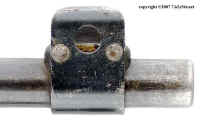 |
 |
Finnish M28/30 |
| The Finnish Civil Guard M28/30 rear sight is a completely new
design specifically for this model. The base is a sleeve around the barrel and soldered in
place with ears at the rear to protect the leaf from damage. It is numbered 2, 4, 6, and 8
on the left side representing hundreds of meters. The leaf is numbered on top with 2, 3,
4, 5, 6, 8, and 10; on the back with 12, 14, 16, 18, and 20; and has a slot down the
middle to untilize the back sight notch. The rear notch is a shallow U shape which is a
separate piece screwed to the bottom of the leaf. |
 |
 |
 |
 |
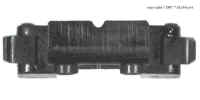 |
| The front sight base has integral ears to protect the blade
and is soldered to the barrel. The blade has a tail that fits inside the base and is held
there by two screws which are also used for adjusting windage. A set screw behind the
blade holds the base on the barrel during the soldering process and a notch in front of
the blade accepts the hook of the muzzle cover. |
 |
 |
 |
Finnish M39 |
| The Finnish M39 was a joint effort between the Army and the
Civil Guard. The rear sight is very similar to the M28/30 with the a few minor changes.
The base is a sleeve around the barrel and soldered in place with ears at the rear to
protect the leaf from damage and also has a bushing at the front to retain the upper
handguard. It is numbered 2, 3, 4, 6, and 8 on the left side representing hundreds of
meters. The leaf is numbered on top with 1.5, 2, 3, 4, 5, 6, 8, and 10; on the back with
12, 14, 16, 18, and 20; and has a slot down the middle to untilize the back sight notch.
The spacing of the numbers varies slightly from the M28/30 leaf. The rear notch is a
deeper U shape with a recess around it and is a separate piece screwed to the bottom of
the leaf. |
 |
 |
 |
 |
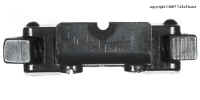 |
| The front sight is essentially identical to the M28/30 but is
mounted approximately one inch from the muzzle as opposed to the M28/30's one half inch.
The base has integral ears to protect the blade and is soldered to the barrel. The blade
has a tail that fits inside the base and is held there by two screws which are also used
for adjusting windage. A set screw behind the blade holds the base on the barrel during
the soldering process and a notch in front of the blade accepts the hook of the muzzle
cover. |
 |
 |
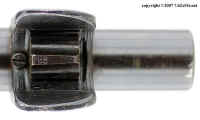 |
M91/30, M38 and M44 rear sight number
variations
These changed over time and it's difficult to determine exact dates or even eras
for the different types. Below are some representative examples. |
| Plain font, no serifs |
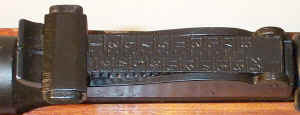 |
| Serifs at the bottom of the 4s and 2s and the top of the 7s |
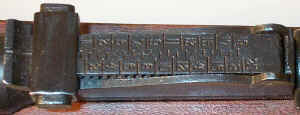 |
| Serifs at the top of the 1s |
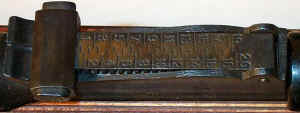 |
| Serifs on 1s, 2s, 4s, and 7s |
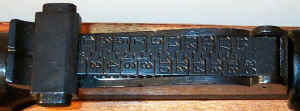 |
| Carbine, small numbers |
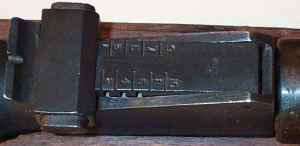 |
| Carbine, large numbers |
 |
M91/30, M38, M44, and T53 rear sight
button variations
As with all Mosin parts, these buttons have been mixed up over time but a general
pattern of use is apparent.
Actual use on individual rifles will vary and it is not uncommon to find two types on one
rifle. |
Crosshatched
Early Soviet M91/30s |
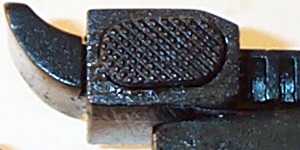 |
| Coarser version, less common |
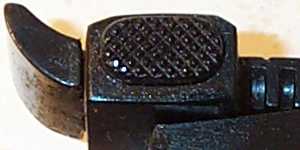 |
| Steeper angle, less common |
 |
Fine vertical lines
Later Soviet M91/30s, M38s, M44s, and Polish M44s |
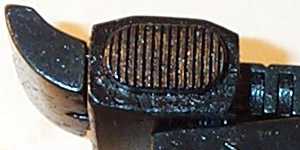 |
Coarse vertical lines
Hungarian and Romanian M44s and M91/30s
and Chinese T53s |
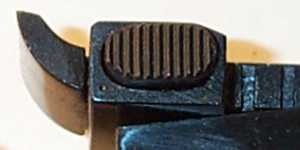 |
Renumbered M91 sights |
| Russian arshins struck through and renumbered in meters by
the Finns. |
 |
| Russian arshins scrubbed and renumbered in meters by the
Finns. |
 |
Russian arshins milled off leaving a "window"
and renumbered in meters by the Finns. |
 |
| No notch cut for 200 meters and "M" for meters by
the Finns. |
 |
| Renumbered in decimals instead of fractions by the Finns. |
 |
Renumbered by the Finns and later "1/2" at
"5" and "8" struck out and
"7" struck out and remarked as "6" by the Finns. |
 |
| Renumbered by the Finns with the old numbers struck through
using a "0". (picture courtesy of "finnmn") |
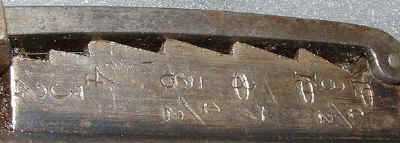 |
| Numbers struck through by the Finns using a "0".
Reverse of the above sight. (picture courtesy of "finnmn") |
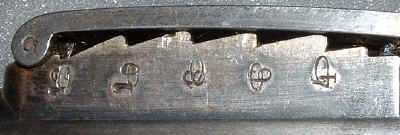 |
| Numbered in Arabic by Turkey and later numbered in meters
by the Finns. (picture courtesy of Eric Johnson) |
 |
| Numbered in Arabic by Turkey and later struck through by
the Finns. (picture courtesy of Arlon) |
 |
| Rear sight leaf elevations renumbered in Arabic by Turkey. (picture
courtesy of "Mitch Stevens collection") |
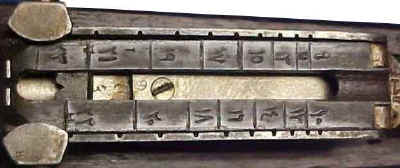 |
| Renumbered by Austria and struck through by the Finns.
Numbered in meters on the opposite side. |
 |



